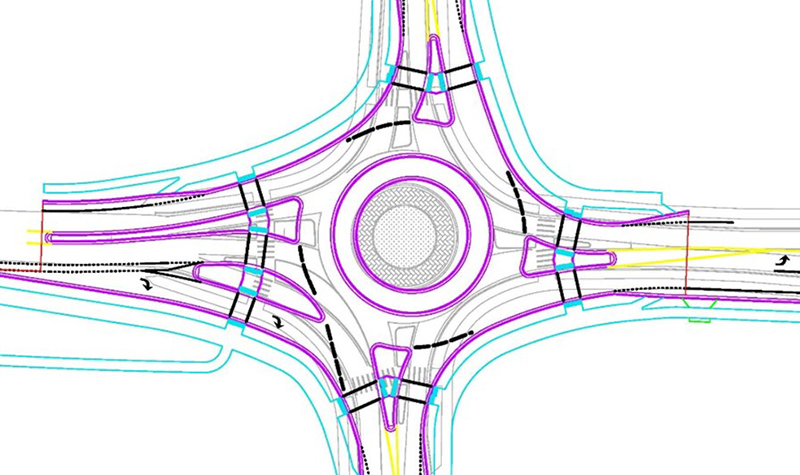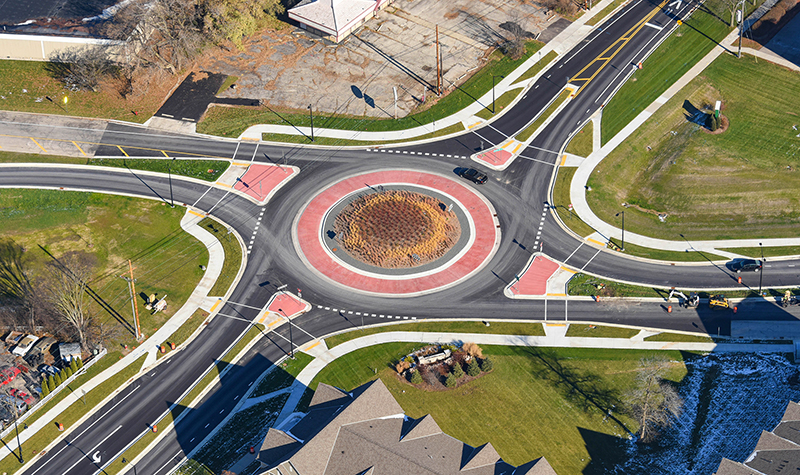Good Roundabout Design Balances Safety and Performance
Properly designed roundabouts can provide excellent operations, improve safety by reducing serious injury and fatal crashes, and provide better bicycle and pedestrian accommodations.
When designed improperly, however, not only can crashes increase, but one poorly designed roundabout also can significantly hinder an agency’s ability to implement additional roundabouts. If drivers go through a roundabout and something just doesn’t feel right (they don’t feel safe, it’s not natural and easy), that is due to poor design.
Some roundabouts are more complicated than they need to be. In the roundabout world, less is more. It’s best to use a multi-lane roundabout only if you absolutely need one. Likewise, don’t add bypass lanes that aren’t warranted, and get rid of left-only entry lanes that require spirals within the circulatory roadway if you can.
Unfortunately there is no easy 10-step checklist on how to design roundabouts. Roundabout design is a balancing act, and there may need to be trade-offs. Designers need to determine the optimal balance between safe provisions, operational performance, and accommodating the design vehicle. Each roundabout requires distinctive design choices, depending on the unique design constraints, traffic volumes, roadway speeds, existing topography, roadway alignments, and other elements. Minor adjustments in geometry can result in significant changes in safety and/or operational performance.
 Roundabout design is more of an art form; there is no absolute right and wrong. It may take a considerable amount of iteration among geometric design, operational analysis, and safety evaluation, which can be very frustrating to designers. That’s why it is so important to have roundabouts designed or reviewed by highly skilled individuals with extensive knowledge and experience.
Roundabout design is more of an art form; there is no absolute right and wrong. It may take a considerable amount of iteration among geometric design, operational analysis, and safety evaluation, which can be very frustrating to designers. That’s why it is so important to have roundabouts designed or reviewed by highly skilled individuals with extensive knowledge and experience.
While every roundabout design is different, each roundabout should include several principles and objectives:
- Be simple for drivers.
- Reduce speeds.
- Provide an appropriate number of lanes.
- Provide smooth channelization.
- Accommodate the design vehicle.
- Accommodate bicycles and pedestrians.
- Provide appropriate sight.
National roundabout guidelines are provided in the National Cooperative Highway Research Program Report 672, Second Edition, released in 2010. Many states and counties have adopted these guidelines and supplemented them with local preferences. These national guidelines are currently being updated.
Here are a few key concepts in roundabout design and review.
Start with an Operational Analysis
No roundabout design or review should start without completing an operational analysis first. Determining the appropriate roundabout lane configuration starts with a thorough operational analysis of the interim and ultimate forecast traffic volumes. Analysis of all peak hour periods is critical to assess the level of performance at each entry and the roundabout as a whole.
Investigate Conceptual Alternatives
Roundabout design may require investigating different sizes, shapes, locations, and approach alignments. Numerous conceptual alternatives may be required, and each is validated using design checks and the roundabout designer’s experience in design composition.
Involve a Roundabout Design Reviewer
Involve a reviewer as early in the design process as possible. Important geometric modifications that may impact the operations and safety performance of the roundabout may not be possible if the review is too late. It is most efficient to have a reviewer work with a designer throughout the design of the roundabout, acting as a resource and mentor, but at a minimum, a review should take place after the preliminary design is completed and before right-of-way acquisition has occurred.
Prepare for Public Involvement
Public involvement can be a key component with roundabout projects. VISSIM microsimulation software, for example, can provide the public with a much clearer idea of how a roundabout will function. The Ayres team is skilled in providing roundabout education and has extensive experience working with agencies, communities, developers, and the public to gain acceptance for challenging roundabout projects. We have been involved with developing public involvement strategies for projects of all sizes, from small projects to larger corridor projects, and have a wide-ranging library of roundabout materials.
Kevin Kuhlow is a leading roundabout designer in the United States. He has been involved with developing hundreds of roundabouts throughout North America since 2000, ranging from mini-roundabouts to complex three-lane roundabouts. He also has worked with several agencies, including the Wisconsin Department of Transportation (WisDOT) and the Florida Department of Transportation, in developing their guidelines. Many of the WisDOT guidelines are used throughout the United States, including development of the fastest path. Kevin has also provided roundabout design training to hundreds of state, county, city, and consultant staff throughout the United States.


 By
By
Post a comment: